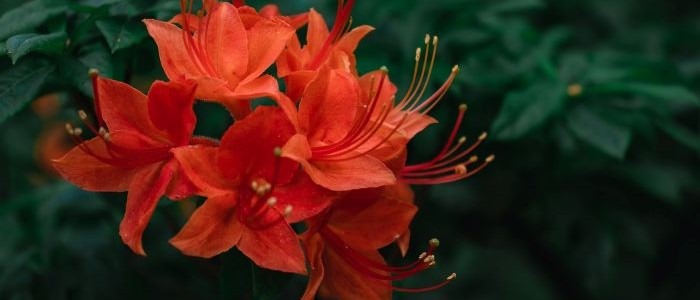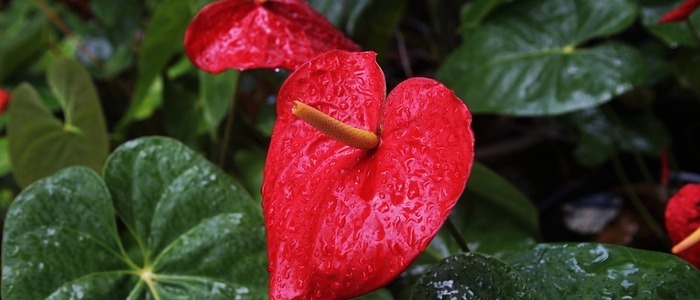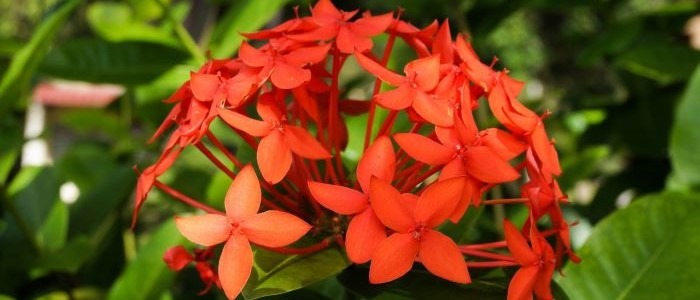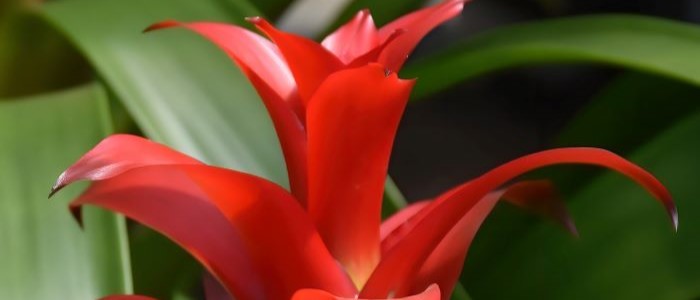The Flame Azalea is a stunning evergreen shrub native to the Appalachian Mountains. It produces bright orange-red blooms that appear in late spring, making it a beautiful addition to any garden. The Flame Azalea can grow up to 6 feet in height and width, making it an ideal choice for hedges or screens.
Its adaptability makes it a great choice for many types of soil, including those with poor drainage. For optimal growth, the Flame Azalea requires full sun to partial shade and is drought tolerant once established.
Its lush foliage and vibrant flowers will make your home stand out from the rest of the neighborhood! With its hardy nature and resilience to pests and disease, this plant is sure to add beauty and life to your garden for years to come. Given the right care, you can be sure that your flame azaleas will thrive in your garden all year round.
Flame Azalea Frequently Asked Questions
What are the light requirements for flame azaleas?
Flame azaleas, also known as Rhododendron calendulaceum, prefer full sun to partial shade. These vibrant and colorful plants thrive in bright, indirect light and can tolerate a few hours of direct sunlight each day. However, excessive exposure to intense sunlight can cause leaf scorching, so it is important to provide some shade during the hottest part of the day. By providing the right amount of light, flame azaleas will flourish and showcase their stunning blooms.
How often should I water my flame azalea?
Flame azaleas should be watered regularly to keep the soil evenly moist. It is important to avoid overwatering as this can lead to root rot. A good rule of thumb is to check the moisture level of the soil with your finger and water when the top inch feels dry. During summer months, they may require more frequent watering to prevent the soil from drying out completely. Additionally, it is crucial to use well-draining soil to prevent waterlogged conditions.

Types of Flame Azalea and Where to Plant Them
There are many varieties of flame azalea, each with its own unique characteristics. Before selecting one for your garden, consider the climate and soil type where you plan to plant it. Flame azaleas do best in full sun to partial shade, depending on the variety, and prefer well-draining, acidic soil. If planting in a container, choose a pot that is at least 16 inches deep and wide and use a high quality potting mix designed for acid-loving plants.
When choosing the right variety for your garden, consider bloom color and size. The most common colors are orange-red and pinkish red but there are several varieties with white blooms as well. Some varieties have dwarf forms while others can reach up to six feet in height and width. It’s important to read the labels carefully before purchasing so you know what to expect in terms of size and color when it is fully mature.
Once you’ve selected the right variety for your garden, it’s time to find the perfect spot for planting. Flame azaleas need plenty of space between plants since they tend to grow outward more than upward. The exact spacing depends on the type of plant but generally they should be planted 3-5 feet apart from each other. When planting in an area with other shrubs or trees, be sure to give flame azaleas enough room so their roots don’t compete for nutrients or water with their neighbors.
Consider how much maintenance you want to commit to caring for flame azaleas before picking out a spot in your garden. Some varieties require more pruning than others due to their habit of growing outward rather than upward so if you’re looking for a low maintenance option pick one that needs less pruning such as ‘Golden Lights’ or ‘Pink Ruffles’ which tend to stay compact easily without needing trimming back regularly.
With this knowledge readers will be able create a beautiful flame azalea display in any outdoor space—from small containers on patios or balconies all the way up large gardens beds filled with these stunning flowers!
How to Plant and Care for Flame Azalea Plant
Commitment and dedication are key components to cultivating a healthy Flame Azalea Plant. To begin, it’s essential to locate the perfect spot in your garden that provides full sun or partial shade and has moist soil; drier conditions can be tolerated. When you have identified the right area, dig a hole twice as large as the root ball of your plant.
Mixing peat moss or compost with the soil is suggested for optimal growth potential. It is important to keep the soil consistently moist but not overly wet, which may cause root rot.
When it comes to pruning flame azaleas, minimal effort is required once they are established due to their low maintenance characteristics. If needed, prune lightly at the end of spring after flowering or early summer for desired size and form.
Additionally, fertilizing should be completed in early spring with an acidic fertilizer such as 10-10-10 slow-release or liquid fish emulsion following manufacturer instructions; repeat every 4-6 weeks until mid-summer when growth slows down significantly and then annually in late winter before new buds emerge on your plant.
Experienced gardeners who wish to expand their flame azalea collection without purchasing more from nurseries can do so with hardwood cuttings! Cuttings taken from semi-hardwood stems should be placed directly into moist potting mix with light misting each day; under ideal conditions they should take roughly 5 weeks until ready for planting into their permanent homes outdoors!
Now that you’re armed with this information about how to plant and care for your Flame Azalea Plant, you can easily create a beautiful display in any outdoor space!
Fertilizing Your Flame Azalea Plant
Fertilizing your Flame Azalea is an important part of caring for this beautiful plant. The best fertilizer to use is one with a balanced N-P-K ratio of 10-10-10, and should be applied in the spring and after blooming. Depending on the size of the plant, use 1/4 teaspoon per gallon for small plants and 1/2 teaspoon per gallon for larger plants. It is important to avoid over-fertilizing, as too much fertilizer can lead to leaf burn or other problems.
When applying fertilizer, it’s best to use a slow release variety that will provide steady nutrition throughout the growing season. This type of fertilizer will also help reduce leaching into groundwater since it breaks down slowly over time. Make sure to water the area thoroughly after fertilizing as this will help ensure that the nutrients reach the roots of the flame azalea plant.
It’s also important to consider soil acidity when fertilizing your flame azalea plant. Many varieties prefer slightly acidic soil so it’s best to add an acidifying product such as sulfur or ammonium sulfate at planting time or in late winter before new growth begins. This helps create ideal soil conditions for optimal growth and flowering of your flame azalea plant.
With the right amount of fertilizer, your Flame Azalea will thrive and produce beautiful blooms all season long! Regular fertilization is key in helping this hardy evergreen shrub reach its full potential, so make sure you follow these steps every year for a stunning display in your garden!
Pruning and Watering Tips for Flame Azalea
Pruning and Watering Tips for Flame Azalea Flame azaleas are an attractive addition to any landscape, but without proper pruning and watering, they can quickly become overgrown or suffer from poor health. Here are some tips that will help you ensure your flame azaleas remain healthy and look their best.
Pruning is essential for keeping your flame azalea in top shape. Prune early on in the springtime before the buds open, using sharp pruning shears to avoid damaging the plant. This will help shape and encourage growth while also removing deadwood or diseased branches that could spread disease to the rest of the plant. Be sure not to prune too heavily or else it can cause damage to the plant and inhibit its growth.
Water is key when it comes to caring for a Flame Azalea plant, as it helps promote healthy root growth and keeps leaves vibrant throughout the summer months. During its growing season, water your Flame Azalea deeply once a week allowing it time to dry out in between waterings so that its roots don’t become oversaturated with water. In addition, mulching with pine needles or bark chips can help keep soil moist and cool during hot summer days. Just be sure not to pile up too much mulch around the base of the plant as this can inhibit air circulation which can lead to fungal problems.
With these simple tips in mind, you will be able to create a beautiful and resilient flame azalea in your garden!
How to Propagate Flame Azalea Plant
Propagating a Flame Azalea Plant can be an incredibly rewarding experience for gardeners. While it may seem daunting, the process is actually fairly straightforward. First, select healthy stems with at least two sets of leaf nodes and use sharp pruning shears to take them. Immediately dip the cuttings into rooting hormone before planting in either soil or water – making sure not to bury any stems under soil nor have any stem parts come in contact with water if propagating in water.
To ensure successful rooting, keep your cuttings warm and moist by misting regularly with lukewarm water and creating a humid microclimate around them by using plastic covers on pots/vases. Additionally, keeping them out of direct sunlight during this time can help reduce stress on the plants during their establishment period.
By following these steps closely, readers will be able to easily propagate their own Flame Azalea plants! With some patience and care, they’ll soon have a beautiful display of flame azaleas that will last for many years to come!
Common Problems and Solutions for Your Flame Azalea
Common Problems and Solutions for Your Flame Azalea Plant Flame azaleas are a beautiful and resilient plant, but there are certain problems that can arise when caring for them. Here are some of the most common problems and solutions for your flame azalea plant:
Diseases: Flame azaleas can be susceptible to diseases such as fungal leaf spots, root rot, or powdery mildew. To prevent these issues, it is important to ensure proper airflow around the plant, avoid overwatering, and keep an eye out for any unusual discoloration or wilting of the leaves. If you notice any signs of disease on your flame azalea, prune off affected branches and apply fungicide to help treat the issue.
Pests: Aphids, mites, caterpillars, and scale insects are all common pests that can harm your flame azalea plant. To prevent these pests from taking hold in your garden, regularly inspect your plants for any signs of damage or stress. If you do find any signs of an infestation on your flame azalea plant you should immediately take action by removing affected branches with pruners or spraying with an insecticidal soap solution. For organic solutions to pest problems try introducing beneficial predators such as ladybugs into your garden or using natural oil-based sprays such as neem oil or horticultural oils.
Reviving a Flame Azalea Plant: If you have a flame azalea that is not thriving it could be due to improper light exposure (too much sun or not enough), incorrect soil pH levels (too acidic/alkaline), nutrient deficiencies in the soil (not enough nitrogen/potassium) or poor drainage leading to root rot. To revive a struggling flame azalea check the light levels in its location; if necessary move it into a shadier spot with plenty of indirect light. Check the pH level of the soil using a tester kit and adjust accordingly (add lime if necessary).
Finally check the soil’s nutrient content and add fertilizer if needed – making sure not to overfertilize! With some patience and care you will soon have a healthy flame azalea back in bloom!
Conclusion
In conclusion, Flame Azalea is an attractive flowering shrub that can add beauty to any garden with minimal maintenance. With the right knowledge and techniques, you can ensure that your Flame Azalea will thrive for years to come.
From selecting the right variety, understanding planting instructions, fertilizing, pruning, watering and propagation techniques to dealing with common pests and diseases – you have all the tools necessary to create a stunning and resilient Flame Azalea plant in your garden.
key is to understand what makes this particular species unique and take steps accordingly. For example, while most shrubs should be watered deeply once a week during the growing season, Flame Azaleas prefer more frequent but lighter watering sessions. Likewise, as they are prone to fungal leaf spot diseases it’s important to keep them away from other plants in order to reduce risk of infection.
By taking the time to research and understand the needs of your Flame Azalea plant you will be rewarded with a beautiful display of color in your garden! With proper care and attention you can enjoy watching this colorful flower bloom for many seasons ahead.
Other Red House Plants













